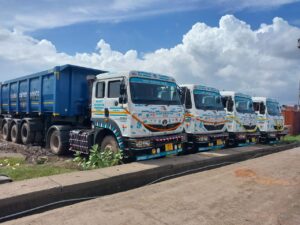The trucking industry serves as an essential economic force which predominantly moves freight through roadways in the United States and India and China. The supply chains rely on this industry to transport billions of tons of goods annually. The global trucking market reaches an estimated worth above $2 trillion and shows consistent growth which stems from the expanding e-commerce industry and growing industrial production and urban development. The United States utilizes trucks to handle 72% of its domestic freight while maintaining a driver workforce that numbers more than 3.5 million people. The figures demonstrate the sector’s magnitude and transformation and emerging trends which makes trucking industry statistics vital for assessing present conditions and projecting future developments.

1. Trucking in the United States
The U.S. has one of the largest and most developed trucking networks in the world.
Freight share: Trucks move 72.6% of total domestic freight by weight.
Annual revenue: The industry generated over $940 billion in 2023.
Employment: Around 3.5 million truck drivers are employed in the U.S., making it one of the largest occupational groups.
Number of trucks: Over 13 million registered trucks, including more than 2 million tractor-trailers.
The demand for last-mile delivery services due to e-commerce growth continues to reshape the trucking landscape.
2.Trucking in India
India is a rapidly growing market in the trucking industry statistics because of infrastructural development and the increase of logistics startups.
- Share in freight: Road transport accounts for about 60% of freight movement.
- Truck population: Estimated 10 million trucks, mostly medium and heavy commercial vehicles.
- Growth: The Indian trucking market is expected to grow at a CAGR of 8-10% over the next five years.
Additionally, government schemes such as the Bharatmala project and logistics parks are contributing to this increase in growth.
3. Key Trends and Technologies
- Electric trucks: The rising interest in electric vehicle (EV) trucks has been the most talked-about trend in the sector. Although the EV truck fleet is still small compared to the gasoline ones, several EV truck models have recently been released. Most of such trucks are small and medium-sized, and they provide the option of completely electric charging. Such a fleet can be used by any.
5. Challenges in the Industry
Although it is large, the trucking industry statistics is haunted by multiple challenges:
- Driver shortages: More than 80,000 drivers are needed to bridge the gap in the U.S. alone.
- Fuel costs: Fluctuating fuel prices have a direct relation to operating margins.
- Infrastructure issues: Besides
6. Future Outlook
The global trucking industry is set to undergo significant transformation through digitalization, green technologies, and policy support. By 2030, road freight volume is expected to grow by over 40%, especially in developing economies. Investments in smart logistics, electrification, and workforce training will be key to sustaining this growth.
Importance of the Trucking Industry
The trucking industry is the hero we don’t notice in our daily lives that is responsible for the afresh shelves, the availability of medical supplies, and the smooth running of businesses. It supports the economy in many ways and thus it is irreplaceable.
- Supply Chain: Trucks are the ones who carry the essential goods that include food, medical supplies, raw materials, etc.
- Employment: The industry is the source of jobs to millions; thus, it supports families and communities all over the country.
- Economic Growth: The movement of goods consequently leads to economic activity and growth.
- Connectivity: Trucks make the connection between different parts of the country, thus even the remotest areas are accessible.
Income and Employment
The trucking industry provides various income opportunities, and truck drivers are often the ones who win the highest salaries among all American workers. Here’s a breakdown:
- Average Salary: Light and delivery service truck drivers make about $41,960 a year, while heavy and tractor-trailer drivers get approximately $46,370.
- Full-Time Earnings: Full-time truck drivers make $100 more weekly than the average full-time American worker.
- Wages: The typical hourly wage for truck drivers in the U.S. is $22.66.
Costs in the Trucking Industry
Costs come in many forms when one is engaged in a trucking business.
- Driver Wages: Currently constitute 32% of total costs that are related to trucking.
- Fuel Costs: Fuel stands for 28% of the budget of a average trucking business.
- Insurance: Increasing truck parking business insurance premiums constitute the largest share of the expenses.
- Miscellaneous Costs: Various mechanical, logistical, maintenance, permits, and tolls are the areas from which these are drawn.
- Driver Benefits: Health insurance, retirement plans, and other benefits make up about 10% of the expenses.
- Repair and Maintenance: Regular upkeep along with unexpected repairs may take up a big part of the budget, thus allowing the trucks to be in good condition.
- Licensing and Regulatory Fees: Adhering to the various state and federal rules entails payment of licensing and regulatory fees which can be quite heavy for trucking companies.
Industry Trends and Forecast
The trucking industry is in a never-ending state of change and is currently undergoing many changes, driven by various trends that define its future:
- Technology: The implementation of trucking technology, including electronic logging devices (ELDs) and telematics systems, is improving compliance and operations.
- Sustainability: The shift towards more environmentally friendly activities is now more evident than ever, and this includes the use of electric and hybrid vehicles.
- Automation: The sectors of autonomous vehicle technology and trucking are collaborating to implement technologies for the long-haul segment of transportation.
Conclusion
The trucking industry is more than getting goods from one place to another—it’s the energizer of the economy. The figures highlight the sector’s magnitude, significance, and transformation in the fast-changing environment. The industry with the proper strategies and innovations is going to remain vibrant and flexible to future market needs.

